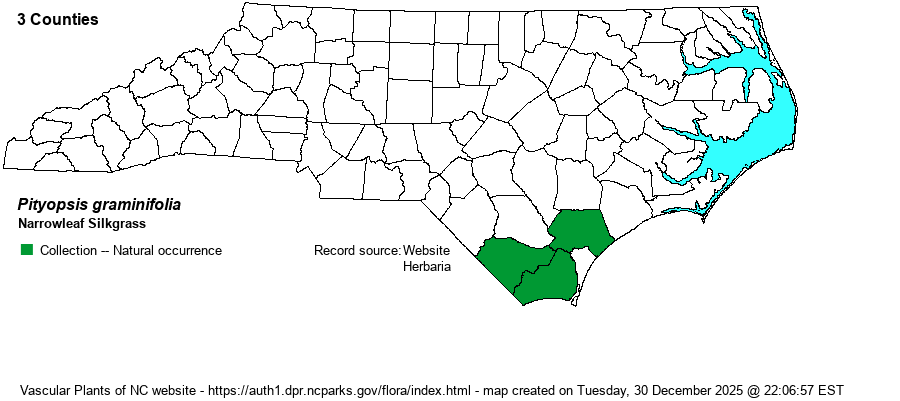| Author | (Michaux) Nuttall | |
| Distribution | Southern outer Coastal Plain, known from just 3 counties so far. A 1934 specimen at NCU from "dry woods, Nakina," Columbus County, was originally determined as Chrysopsis argentea and finally annotated in 2020. Sadly, SERNEC contains many dozens of specimens still labeled as the former P. graminifolia -- mainly now assigned to P. aspera if not also P. nervosa -- such that careful study of the specimens is badly needed. One of the editors (Sorrie) has done much of that, winnowing these specimens to now just 3 counties. In addition, iNaturalist also is unreliable for determining species of this genus owing to numerous splitting and renaming of species.
Coastal Plain, southeastern NC to central FL and southeastern LA. | |
| Abundance | Rare to locally uncommon, and presumably overlooked. Often forms patches, due to long horizontal rhizomes. The NCNHP database contains only 4 records, here at the northern limit of its range. It is listed as State Endangered. | |
| Habitat | Primarily in moist Longleaf Pine-Wiregrass savannas. It can occur in drier pinelands and sandy roadsides. |
| Phenology | Flowering and fruiting July-October. | |
| Identification | The genus Pityopsis has been split from Chrysopsis (the golden-asters) and from Heterotheca (camphorweeds) by the silky, silvery, appressed hairs on leaves and stems. Narrowleaf Silkgrass grows 1.5-2.5 feet tall, with basal leaves 10-20 mm wide and stem leaves that become greatly reduced upwards. Despite the common name of "narrowleaf", it suggests a very robust Pineland Silkgrass (P. aspera), but with larger and wider leaves, larger heads, and lacking stalked glands on the stem. Note the presence (usually) of patches of basal leaves that may or may not have flowering stems. It is extremely similar to P. nervosa but has heads with fewer florets (a maximum of 29 vs. a minimum of 30) and shorter involucres (5-8 mm long vs. 9-14 mm in the latter species). | |
| Taxonomic Comments | The taxonomic and nomenclatural history of Pityopsis is complex; a good summary can be found in Semple & Bowers (1985). Note that this is not the "Heterotheca graminifolia" in RAB (1968), but instead their H. correllii.
In the understanding of the genus Pityopsis, great strides were made in the monograph by Semple and Bowers (1985, with keys, drawings and maps). Very recently, Bridges and Orzell (2018) revised some of the Florida taxa, based on examination of type specimens and lengthy field work (includes keys, maps). Finally, Nesom (2019) produced a synopsis of the genus (with full synonymy, keys and maps). Note that the taxonomic concepts of these authors, Weakley (2020, 2022), and us do not always agree; therefore, readers are encouraged to get familiar with these works and also get to know well your local plants. | |
| Other Common Name(s) | Grass-leaved Golden-aster, Grassleaf Silkgrass | |
| State Rank | S1? | |
| Global Rank | G5T4 [G4] | |
| State Status | E | |
| US Status | | |
| USACE-agcp | UPL link |
| USACE-emp | UPL link |

